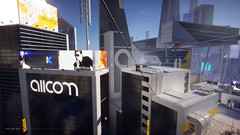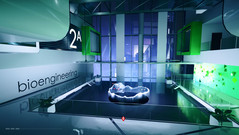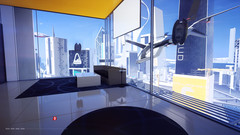Mirror's Edge Catalyst Notebook and Desktop Benchmarks
For the original German article, see here.
Graphics
Like most current Triple-A product from EA, Mirror's Edge Catalyst is based on the mighty Frostbite 3 engine, which also powers Battlefield 4, Star Wars Battlefront, Need for Speed and Dragon Age Inquisition. The engine is know for high quality, but also high demands on the hardware. According to the manufacturer, the 2017 iteration of the soccer game Fifa will make use of Frostbite 3 as well.
Back to Mirror's Edge: compared to the predecessor from 2009, Catalyst appears more modern as far as graphics are concerned. Reflections as well as light and shadows are top notch. The game is characterized by outstanding animations, very compelling day/night transitions and a - similar to the first installment - very individual look with strong contrasts and single-color object areas, which at times look like abstract art. Occasionally, Catalyst looks a little too "clean" and sterile, however.
Let's touch upon texture sharpness, which is - although not up to the standard of other Frostbite games - pretty decent overall. Unfortunately, there are still a few bugs and inconsistencies. When the graphics option "GPU Memory Restriction" is turned on, some of the objects suffer - independently of the other settings - from fairly undefined textures.
Our assumption: once the GPU's VRAM becomes scarce, Mirror's Edge automatically loads lower-grade textures. Even though deactivating the "GPU Memory Restriction" supposedly threatens the stability, we would generally avoid having the option turned on. We didn't encounter any problems at all during our testing period.
We only experienced difficulties at the highest quality level - called hyper - which was announced shortly before launch. Yes, the shadows are even more defined, and yes, even more objects are visible at a distance. But the visual improvements stand in no relation to the loss in performance, as even potent desktop GPUs like the GeForce GTX 980 hit their limit already at Full-HD resolution. The frame rate during our NBC test sequence dropped from a fluent 76 to only 29 fps (ultra vs. hyper). Catalyst then was also prone to crashes and strange performance drops.
Otherwise, the engine looks good - minor graphics and clipping errors notwithstanding. The load times are OK with SSDs, but HDDs require more patience. The download isn't too large considering it's 2016 - many other games require substantially more room than 23 GB (Doom, for examples needs ~50 GB).
For PC gamers, the "base of operations" is the graphics menu, which contains an adequate number of options. In addition to the brightness, the field of view, and the picture mode, the overall quality is adjustable as well in several steps. A great feature: advanced users can select from nine different detail settings (Ambient Occlusion, Motion Blur, …).
We are not completely satisfied with the options. One one hand, the user has to - depending on the resolution - resort to scrolling. We also consider it a nuisance that there's no anti-aliasing switch and that changes require a restart. We also would like to see explanations for some of the settings.
The main problem of Catalyst is the content itself. The gameplay and the sense of motion (aside from the boring fights) are well done, but other sources of amusement are rather standard-fare missions (hack x, steal y, deactivate y). EA seems to follow their competitor Ubisoft here - Assassin's Creed, Watch Dogs, Far Cry, and The Division also suffer at times from uninspiring tasks designed to fill the humongous world.
The upgrade system seems contrived as well and the fair-to-middling story suffers as a result. We couldn't warm up to the characters at all during our during our initial gaming session, which lasted for several hours. To bad - the surveillance scenario in particular would have a lot to offer.
Benchmark
Since Catalyst comes with only one profile and one savegame, it took us a while to find a suitable benchmark sequence. At the end, we chose the beginning of the second mission, called "Old Friends". We start the tool Fraps after Faith gets hold of a control chip and steps through the door on the opposite side (see video). What follows is a 20 second sprint, jump and sliding stunt over bright white rooftops. This sequence represents the gameplay very well and offers insight into what performance can be expected.
Since this is a brisk first-person title, the frame rate should be 35-40 fps on average. More than 200 frames per second are not possible because of an fps limit.
Results
Users who can do without 3840 x 2160 pixels and the hyper setting, need a powerful, but not outrageously fast high-end notebook. A combination of 1920 x 1080 pixels and the ultra preset runs well on an GeForce GTX 970M on up (GTX 880M+ for High). Side note: analyzing the benchmarks clearly shows Nvidia's Maxwell architecture to be superior to the old Kepler technology. Owners of gaming notebooks costing between 1000 and 1500 Euro (~$1130 - 1690) are likely going to ask the FHD question: can I play Catalyst at full resolution with a GeForce GTX 960M? The answer is yes - but only at up to medium details.
Owners of multimedia notebooks with upper middle-class GPUs (GTX 950M etc.) can use the preset medium only at 1366 x 768 or 1600 x 900 pixels without encountering stutters. Inexpensive allrounder-notebooks (up to GeForce 940M) can use low settings at best. Notebooks without dedicated GPUs are out of the question: an Intel HD Graphics 4600 managed not even 25 fps at minimum details and at a resolution of 1280 x 720 pixels.
The results were mixed for AMD APUs. We were unable to install the newest 16.6.1 beta driver on the desktop APU 7850K or an Asus notebook with Kaveri APU. Maybe that's why the Radeon R9 M280X (Kaveri-based Asus N551ZU) was too slow and couldn't produce playable frame rates. The 7850K APU stuttered initially, but subsequent runs showed higher frame rates. Conceivably we need to wait for a new driver here.
| Mirror's Edge Catalyst | |
| 3840x2160 High Preset AF:16x 1920x1080 Ultra Preset AF:16x 1920x1080 High Preset AF:16x 1920x1080 Medium Preset AF:4x 1366x768 Medium Preset AF:4x 1280x720 Low Preset AF:2x | |
| NVIDIA GeForce GTX 1080 (Desktop), 4790K | |
| NVIDIA GeForce GTX 980 Ti, 4790K | |
| AMD Radeon R9 Fury, 4790K | |
| NVIDIA GeForce GTX 980, 6700K | |
| AMD Radeon R9 290X, 4790K | |
| NVIDIA GeForce GTX 980M, 4700MQ | |
| NVIDIA GeForce GTX 970M, 4700MQ | |
| NVIDIA GeForce GTX 950, 6700K | |
| NVIDIA GeForce GTX 880M, 4700MQ | |
| AMD Radeon R7 370, 4790K | |
| NVIDIA GeForce GTX 965M, 6700HQ | |
| NVIDIA GeForce GTX 870M, 4700MQ | |
| NVIDIA GeForce GTX 960M, 4720HQ | |
| NVIDIA GeForce GTX 950M, 6700HQ | |
| NVIDIA GeForce GTX 860M, 4700MQ | |
| NVIDIA GeForce 940MX, 6700HQ | |
| NVIDIA GeForce 940M, 5700HQ | |
| AMD Radeon R9 M280X, FX-7600P | |
| NVIDIA GeForce 920M, 2970M | |
| NVIDIA GeForce GT 720M, 4200M | |
| Intel HD Graphics 4600, 4700MQ | |
Overview
Testsysteme
| Desktop PCs | Custom Nvidia | Custom AMD |
|---|---|---|
| Mainboard | Asus Z170-A | Asus Z97-Deluxe |
| Processor | Intel Core i7-6700K (Skylake) | Intel Core i7-4790K (Haswell) |
| GPU | Nvidia GeForce GTX 980 (4 GB GDDR5) PNY GeForce GTX 950 (2 GB GDDR5) |
Nvidia GeForce GTX 1080 (8 GB GDDR5X) Asus GeForce GTX 980 Ti (6 GB GDDR5) XFX Radeon R9 Fury (4 GB HBM) Sapphire Radeon R9 290X (4 GB GDDR5) Sapphire Radeon R9 280X (3 GB GDDR5) MSI Radeon R7 370 (2 GB GDDR5) |
| RAM | 2x 8 GB DDR4-2133 | 2x 4 GB DDR3-1600 |
| Storage | Crucial MX100 SSD (256 GB) Crucial M500 SSD (480 GB) OCZ Trion 100 SSD (480 GB) OCZ Trion 150 SSD (960 GB) |
Intel SSD 530 (240 GB) OCZ Trion 100 SSD (480 GB) |
| OS | Windows 10 Pro 64 Bit | Windows 10 Home 64 Bit |
| Schenker Notebooks | Schenker W504 | Schenker XMG A505 | Schenker S413 |
|---|---|---|---|
| Mainboard | Intel HM87 | Intel HM87 | Intel HM87 |
| Processor | Intel Core i7-4700MQ (Haswell) | Intel Core i7-4720HQ (Haswell) | Intel Core i7-4750HQ (Haswell) |
| GPU | Nvidia GeForce GTX 980M (8 GB GDDR5) GTX 970M (6 GB GDDR5) GTX 880M (8 GB GDDR5) GTX 870M (6 GB GDDR5) GTX 860M Kepler (4 GB GDDR5) |
Nvidia GeForce GTX 960M (2 GB GDDR5) | Intel Iris Pro Graphics 5200 |
| RAM | 2x 4 GB DDR3-1600 | 2x 4 GB DDR3-1600 | 2x 8 GB DDR3-1600 |
| Storage | Samsung SSD 840 EVO (250 GB) Seagate Laptop Thin SSHD (500 GB) |
Micron M600 SSD (128 GB) HGST Travelstar 7K1000 HDD (1.000 GB) |
Intel SSD |
| OS | Windows 10 Pro 64 Bit | Windows 10 Home 64 Bit | Windows 10 Home 64 Bit |
| MSI Notebooks | MSI GE72 | MSI PE60 | MSI GP62 | MSI CX61 | MSI CX61 |
|---|---|---|---|---|---|
| Mainboard | Intel HM170 | Intel HM170 | Intel HM86 | Intel HM86 | Intel HM86 |
| Processor | Intel Core i7-6700HQ (Skylake) | Intel Core i7-6700HQ (Skylake) | Intel Core i7-5700HQ (Broadwell) | Intel Celeron 2970M (Haswell) | Intel Core i5-4200M (Haswell) |
| GPU | Nvidia GeForce GTX 965M 2016 (2 GB GDDR5) | Nvidia GeForce GTX 950M (2 GB GDDR5) | Nvidia GeForce 940M (2 GB DDR3) | Nvidia GeForce 920M (2 GB DDR3) | Nvidia GeForce GT 720M (2 GB DDR3) |
| RAM | 1x 8 GB DDR4-2133 | 2x 4 GB DDR4-2133 | 1x 8 GB DDR3-1600 | 1x 8 GB DDR3-1600 | 1x 8 GB DDR3-1600 |
| Storage | Toshiba THNSNJ128G8NU SSD (128 GB) WDC WD10JPVX HDD (1.000 GB) OCZ Trion 100 SSD (480 GB) |
Toshiba MQ01ABF050 HDD (500 GB) | WDC Scorpio Blue HDD (1.000 GB) | ||
| OS | Windows 10 Home 64 Bit | Windows 10 | Windows 10 | Windows 10 | Windows 7 Home Premium 64 Bit |
| Other Notebooks | Asus N551ZU |
|---|---|
| Mainboard | AMD K15.1 |
| Processor | AMD FX-7600P (Kaveri) |
| GPU | AMD Radeon R9 M280X (4 GB GDDR5) |
| RAM | 2x 4 GB DDR3-1600 |
| Storage | Samsung SSD 830 256 GB |
| OS | Windows 10 64 Bit |
| 4K Monitor | Nvidia driver | AMD driver | Intel driver |
|---|---|---|---|
| 2x Asus PB287Q | ForceWare 368.39 | Crimson 16.6.1 Hotfix | 15.40.22.4424 |


 Deutsch
Deutsch English
English Español
Español Français
Français Italiano
Italiano Nederlands
Nederlands Polski
Polski Português
Português Русский
Русский Türkçe
Türkçe Svenska
Svenska Chinese
Chinese Magyar
Magyar





































